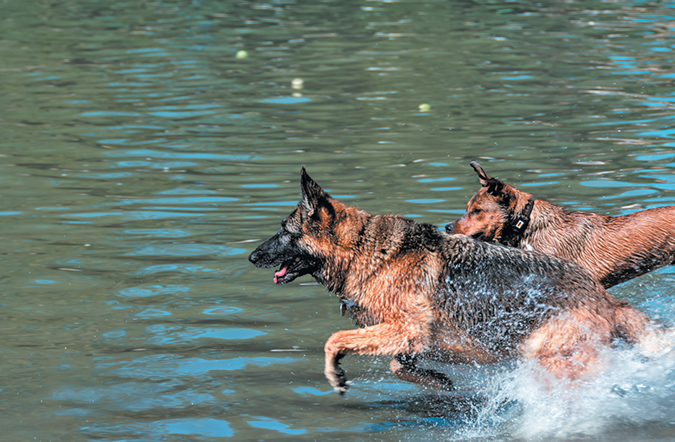
© Simone OBrien | Bigstock
There’s no getting around it — dogs can smell pretty stinky. Some of the odor comes from bacteria and yeast in the skin that break down and oxidize oils (fats) on the skin’s surface. That fat breakdown releases the telltale volatile compounds that we associate with dogs’ un-perfume-like scent. Some of the nasty odor also comes from the waste left behind on a dog’s coat by resident microorganisms, and some comes from sweat.
It’s all the more noticeable when a dog gets wet. As water evaporates, it releases the malodorous compounds from the skin and fur, which is why dogs smell worse after being out in the rain.
None of this means your dog has come down with an illness. Bacteria and yeast also live naturally on the skin of people. If we bathed once every month or two instead of every day, the breakdown of the oils on our skin, to say nothing of the sweat we produce, would make us smell pretty rank, too.
But sometimes, the odor goes beyond the usual — and in those cases something might be going on that’s not normal. Five conditions in particular tend to make people wonder why their dog smells so bad — and what they can do to solve the problem.
Dental decay. The build-up of plaque and tartar on a dog’s teeth can make his mouth smell like the inside of a whale. Gum disease that worsens as the problem escalates only makes the odor worse. You should brush your dog’s teeth every single day to impede the process. But even if you do, his teeth will require a thorough cleaning now and then by a veterinarian. Once a dog passes through middle age, debris will continue to build up below the gum line, where a toothbrush can’t reach. The vet will need to anesthetize your pet to get the job done with special instruments. It’s worth it. Advanced tooth decay can lead to pain and disease (and stench) so bad that teeth need to be pulled.
Flatulence. If your dog frequently passes gas (the odor can clear a room), you might be feeding him a food that disagrees with him. Speak with your vet about the advisability of changing his diet to remove — or add — a particular ingredient that could calm his tummy. In some instances, the vet may say that the flatulence is potentially a sign of an underlying gastrointestinal disorder requiring further investigation.
Ear dirt/Otitis. Both the buildup of wax and other debris inside the ear canal and the discharge that comes with otitis (inflammation of the ear canal) can result in a very unpleasant scent. Dogs with floppy ears can really benefit from having their ears cleaned every week or two, as can breeds with narrow ear canals (like shar-peis), brachycephalic breeds (who also tend to have narrow ear canals), and dogs who live in humid climates, where wax buildup is more likely.
Don’t used a cotton-tipped swab. There’s a sharp turn inside a dog’s ear canal, too sharp for the fluffy cotton to make. It only ends up pushing the gunk further in. Instead, use a liquid ear cleaner such as Epi-otic, Otoclean, Malacetic Ear Cleaner, Oti-clens, TrizEDTA or Douxo.
Impacted anal sacs. Dogs have two anal glands that produce a fluid believed to give a dog’s excrement a characteristic odor that other dogs find interesting. This odiferous anal sac fluid normally passes from the anal sacs each time a dog voids. The pressure of pushing out the waste does the trick. But in some dogs, the tiny, narrow duct through which the fluid leaves the sacs becomes plugged, or impacted— uncomfortable for the dog and more than a little unpleasant for your nose. Often, a veterinarian can express the fluid by putting a finger up the rectum and squeezing the sac until the liquid comes out. But if a dog repeatedly has the problem, another solution is called for.
One is to give your pet a higher-fiber diet. The extra volume may have a better chance of pushing out the fluid. You can also learn to express the anal sacs yourself. If that’s above your pay grade, you can have the anal sacs removed surgically. They are not a necessary part of the anatomy.
Tufts veterinarian Ramon Almela, DVM, notes that in some cases, a dog with an underlying gastrointestinal issue may be prone to anal sac problems. If the GI issue can be cleared up, the anal sac problems clear up.
Atopy. A susceptibility to allergies that play themselves out on the skin, atopy can cause an excess of oil secretions that increase skin odor as well as set the stage for bacterial infections that may come with foul odors of their own. A dog with atopy will often become very itchy. Once the allergy is controlled, the unpleasant aroma will dissipate.




